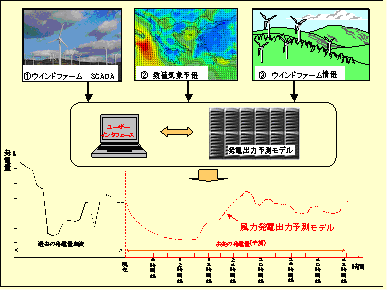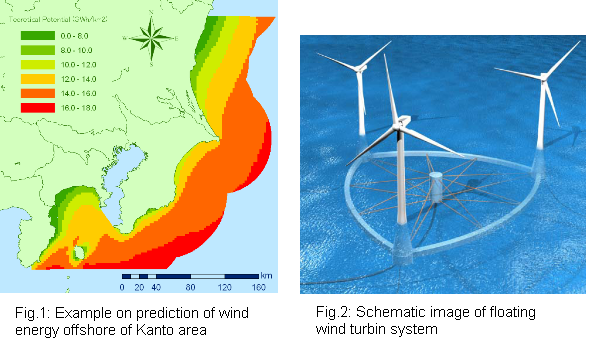Wind Energy
Development of wind power prediction based on weather forecast
It is known that the output of wind energy facilities fluctuates with the variation of wind velocity. Since the percentage of wind energy in the whole electricity system increases rapidly in recent years, It has raised up the concern about the its effect on frequency of the whole electricity system. In this project, a power prediction system using online output power observation data and numerical weather prediction model, which considers Japan's complex topography and weather, is developed. The system can predict power output of the same day and the next day with high accuracy. Online observation of 9 wind farms in northeastern Japan is also carried out. The purpose of this project is to develop a Japanese wind power prediction system, which considers Japanese wind energy characteristics like easy changing of weather, turbulence, accidental stop. This prediction system is the result of wind farm power curve model development, wind prediction accuracy improvement, and benchmark test of Japanese and non-Japanese models based on the observed data. The final goal is a wind power prediction platform which can flexibly deal with prediction models and data which may contributes to the development of wind energy proliferation.

In this study, the new prediction model called "Dynamical Statistical Downscaling" has been developed. This new model gives a resolution of about 10m, which is about several hundred times more local than the conventional ones. The prediction error of this model is about one-third of the conventional ones, which means several percents. The result of this study is used to improve transmission line's design and maintenance; to create the wind hazard map area along rail way; etc.
Development of floating offshore wind energy system
With the rapid development of wind energy in Japan, area of land, which is good for erection of wind turbine, has been decreasing. Since the fluctuation of power output also strongly effects the frequency of the whole electricity system restriction in deploying of wind energy has been restricted. Currently, the University of Tokyo and the Tokyo Electric Power Company have been paying attention to the enormous wind energy offshore Kanto area. Collaborative study on the feasibility of floating offshore wind turbine system, which can be applied in deep-sea area, has been started. The study clarifies the suitability of the area through wind observation using a 94m height gas platform, 37km offshore of Fukushima prefecture and wind energy calculation using weather simulation. Since floating offshore wind energy system is subjected to winds, waves and tides safely designed floating basement is required. In this study, along with development of a light floating structure, production-transportation and deployment which consider wave and draft's effect and method to reduce bad vibration effect on durability of floating structure are proposed. Besides, a numerical program is developed to evaluate the fluctuation and strength of floating structure. This program is validated through experiments. The purpose of this study is to develop a floating structure system which is not only safe but also economical by considering the structure's fatigue and limited state in various natural condition.


